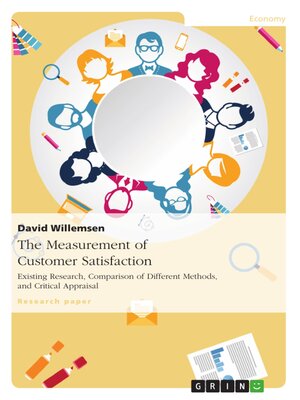The Measurement of Customer Satisfaction
ebook ∣ Existing Research, Comparison of Different Methods, and Critical Appraisal · Aus der Reihe: e-fellows.net stipendiaten-wissen
By David Willemsen

Sign up to save your library
With an OverDrive account, you can save your favorite libraries for at-a-glance information about availability. Find out more about OverDrive accounts.
Find this title in Libby, the library reading app by OverDrive.



Search for a digital library with this title
Title found at these libraries:
| Library Name | Distance |
|---|---|
| Loading... |
Research Paper (undergraduate) from the year 2010 in the subject Business economics - Offline Marketing and Online Marketing, grade: 1,0, RWTH Aachen University (Lehrstuhl Wirtschaftswissenschaften für Ingenieure und Naturwissenschaftler ), language: English, abstract: Only those companies that fully satisfy their customers will be able to maintain a top market position in the long run. Despite the fact that this rule has been known for a very long time, it has drastically gained in importance in the last years. The reasons are multifarious, but three main aspects can be named: the upswing of customer needs, exacerbating competition, and more complex market conditions. Rising customer demands can best be explained by a growing range of products competing against each other. In times of fierce competition, companies must deliver optimal products for the purpose of maintaining their competitiveness and strengthening their market positions. To ensure maximum customer loyalty, it is essential to know the status quo regarding the so called customer satisfaction and how consumer needs developed over time. This thesis presents the current state of research in the field of customer satisfaction measurement. In its macro-structure it can be divided into a theoretical and an empirical part. In the first one, the main measurement and calculation methods are described and discussed with focus on their capability to provide valid and reliable results concerning customer satisfaction. Chapter 2 sets the thematic framework by examining different conceptions of the formation of customer satisfaction. On this basis, a coarse presentation and categorization of prevalent measurement approaches is given. Not all of those approaches are up to today's standard of providing valid and reliable measures. Hence, in Chapter 3, only the promising subset of those approaches is further analyzed. Those methods are critically analyzed and assessed with the help of the existing literature. Building on this, a holistic customer satisfaction measurement system is introduced. Subsequently, Chapter 4 addresses the issue of comparability of different customer satisfaction measures and represents the transition from the theoretical to a praxis-based empirical part. Chapter 4.1 focuses on challenges for obtaining comparable data in international measurements. A closer look is taken at the different national CSI models as well as a recently established uniform European approach. Furthermore, study results of individual countries and industries are examined for their similarities and differences. The thesis concludes with a summary of the most important findings and provides an outlook on future developments in the field of customer satisfaction research.







